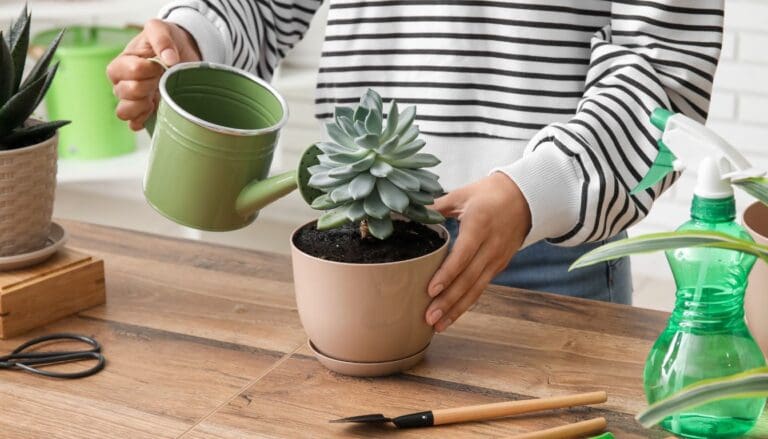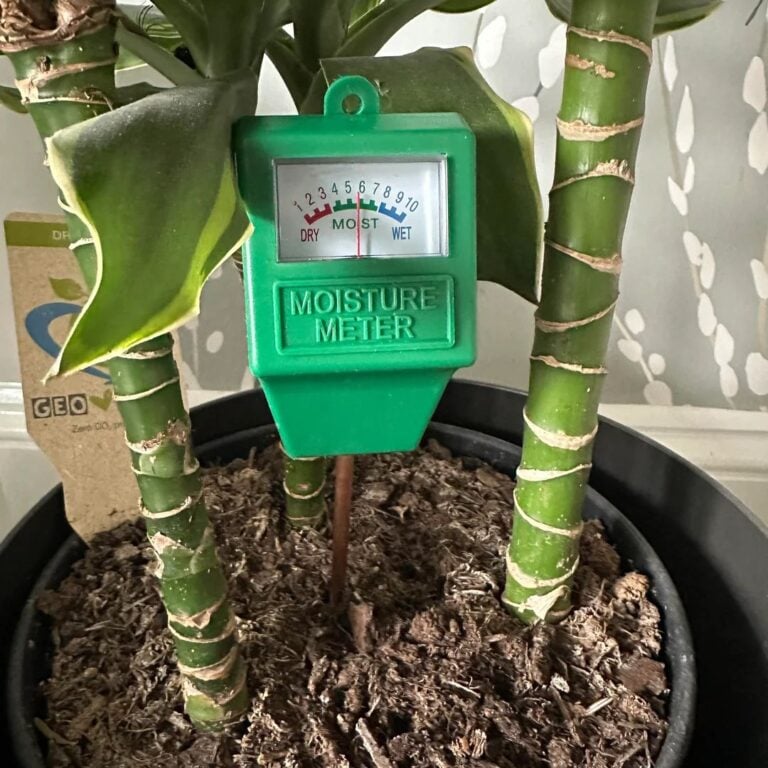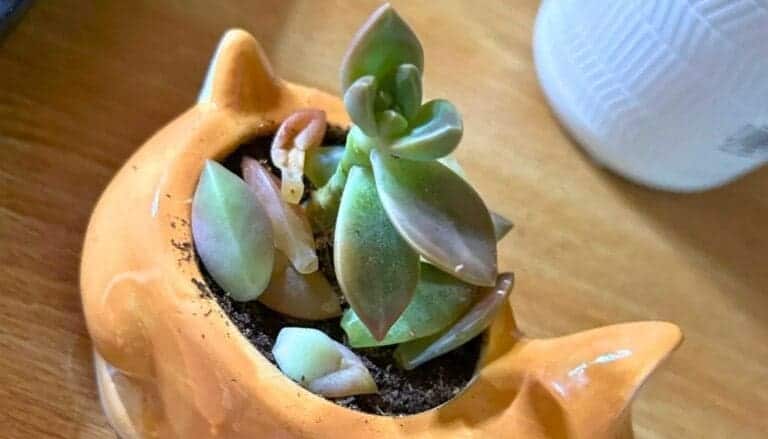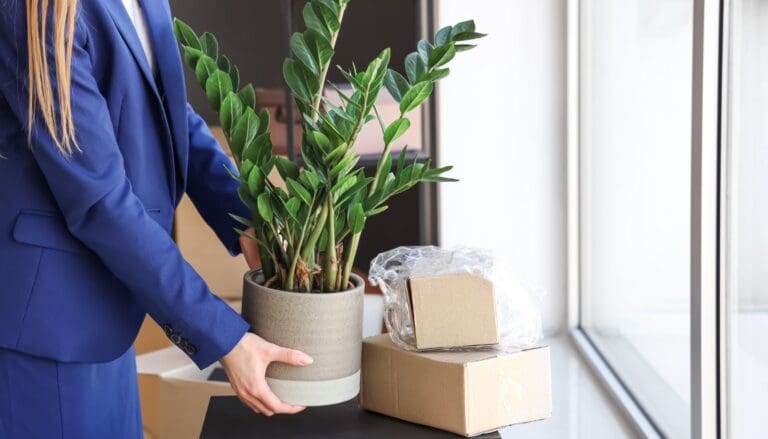10 Winter Plant Cleaning Hacks You Must Try!
Keeping plants fresh in winter can feel like a real challenge, right? Dust, dry air, and those gloomy days seem to drain the life out of them.
That’s why I lean on a few cleaning hacks to help my plants stay bright and happy all season.
When I give my plants a bit more attention, I actually see them perk up. Even a few easy habits can make a big difference, especially when the weather outside isn’t exactly plant-friendly.
Please note: Simplify Plants is reader-supported. As an Amazon Associate, I earn from qualifying purchases made by our readers with no extra cost added to you all! Some links in the post are affiliate links and I get a commission from purchases made through links in the post.
1) Dust leaves with a soft microfiber cloth

I reach for a soft microfiber cloth to wipe down my plant leaves. It’s gentle, doesn’t scratch, and honestly, it just works.
Supporting each leaf with one hand, I wipe with the other—just enough pressure to lift the dust but not enough to bend or snap anything.
I go through the leaves one at a time. It’s a little meditative, and the leaves look noticeably brighter right away.
Clean leaves really do soak up more light, which matters so much during those short winter days. It’s a tiny thing, but it helps.
If my cloth gets too grimy, I rinse it out. No sense in spreading dust from one plant to the next.
2) Use a gentle spray of diluted vinegar to clean plant leaves
A diluted vinegar spray is my go-to for stubborn dust and light residue. Vinegar, when mixed right, isn’t harsh at all.
I mix one part vinegar with ten parts water—nothing stronger. That keeps things gentle for the leaves.
Instead of spraying the plant directly, I spritz a soft cloth and wipe the leaves. It gets them clean and shiny without overdoing it.
I skip this trick for fuzzy or delicate leaves; plain water is safer for those. No need to risk it.
Vinegar spray is quick and simple, and it really helps keep winter dust in check.
3) Wipe leaves with milk to boost shine

Mixing a splash of milk with water is a quirky trick I use for shiny, dust-free leaves. It’s easy and doesn’t involve any weird chemicals.
I dip a soft cloth in the mix and gently wipe. The leaves get a subtle glow, especially on smooth types like rubber plants or pothos.
The proteins in milk give the shine, but I go easy—too much and things get streaky. Just a light wipe does the job.
I only do this once a month or so. It’s quick, safe, and makes a difference without much effort.
4) Trim yellowing leaves to encourage new growth

As soon as I spot yellowing leaves, I trim them off. No point letting the plant waste energy on parts that are on their way out.
Clean scissors or pruning shears are a must—nothing fancy, just wiped down with rubbing alcohol before and after.
I make a neat cut near the base of the leaf stem. The plant usually responds by putting out new shoots or fresh leaves, which is always satisfying to see.
If a leaf is only partly yellow, I let it be until it fades more. I figure the plant can still use the green part for a while.
It’s a small thing, but keeping up with trimming keeps everything tidy and healthier overall.
5) Mist succulents lightly to avoid overwatering
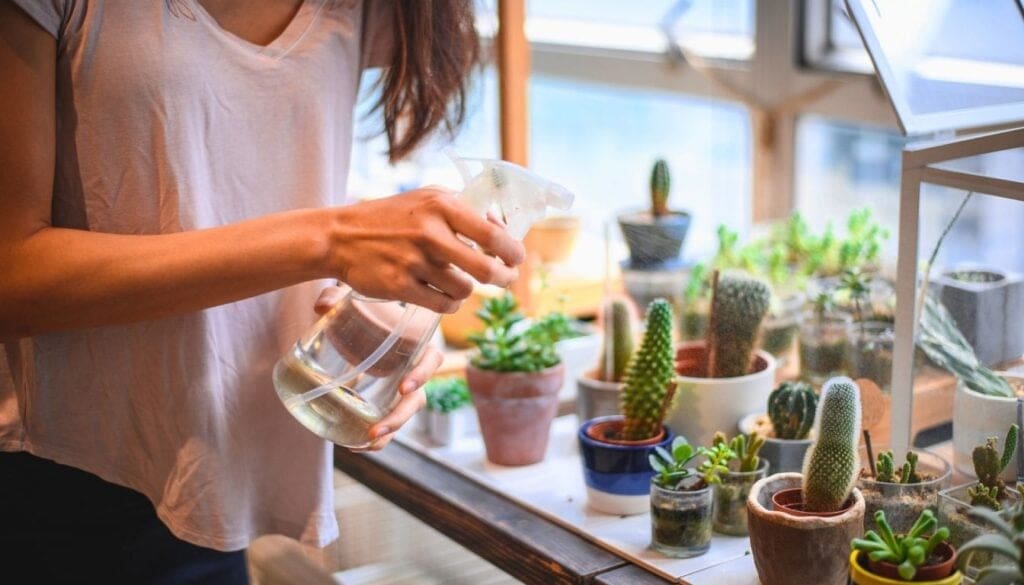
Succulents are pretty self-sufficient, especially in winter. They store their own water, so I try not to fuss with them too much.
Instead of pouring water, I just mist the top layer of soil with a spray bottle. It keeps dust down and gives a hint of moisture without risking root rot.
A quick, gentle mist does the trick. Too much water is a recipe for disaster—been there, don’t want to go back.
I check the soil first; if it’s still damp, I wait. That habit has saved more than one plant from overwatering.
6) Clean spider plant leaves with lukewarm water
Spider plant leaves pick up dust fast, so I rinse them off with lukewarm water. Cold water is too shocking, and hot water is just asking for trouble.
I’ll either hold smaller plants under a gentle stream or use a spray bottle for bigger ones. Lukewarm water lifts the dust and doesn’t leave streaks.
After rinsing, I let the plant air dry in a bright spot. I avoid wiping too hard—those leaves bend so easily.
It’s such a simple thing, but it really helps spider plants breathe and look better all winter.
7) Remove dust from ferns using a soft brush

Ferns are delicate, so I use a soft brush—like a makeup or paintbrush—to sweep dust away. Cloths just don’t cut it for those feathery fronds.
I start at the base and brush outward with light strokes. It keeps the dust from getting stuck deeper in the plant.
I give my ferns a quick brush every couple of weeks. Dust seems to build up faster indoors in winter, and ferns need all the light they can get.
For stubborn spots, I steady the frond with one hand and brush with the other. It’s quick, easy, and keeps my ferns happy.
I keep one brush just for plants. It’s a tiny investment for a lot of peace of mind.
8) Repot plants in fresh soil for winter health
Before winter hits, I like to repot my plants in fresh soil. Old soil gets tired, and new soil gives the roots a fresh start.
I gently shake off the old soil, trim away any weak roots, and pop the plant into a pot with good drainage holes. No soggy roots for me, thanks.
Fresh soil also means fewer pests and less fungus. I’ve noticed plants seem less stressed when they get this little upgrade.
I don’t repot every plant—just the ones that look crowded or have roots poking out. For the rest, I add a thin layer of fresh mix on top.
Repotting in fall or early winter sets things up for a strong spring. It’s one of those simple steps that really matters.
9) Use a toothbrush to clean hard-to-reach spots
An old toothbrush is perfect for cleaning those tiny spaces between stems and around leaf joints. The bristles get in where a cloth can’t.
Dust loves to hide in those nooks, and a toothbrush helps me gently loosen it up. I dip it in lukewarm water first for a softer touch.
For stubborn dirt, I’ll add a drop of mild soap to the water—just a drop—and rinse well after. No one wants soapy leaves.
I move the brush in little circles, especially on textured or fuzzy leaves. It’s surprisingly effective.
While brushing, I sometimes spot pests hiding out. That’s a bonus—catching them early saves a lot of headaches.
I keep a dedicated toothbrush just for plants. It’s a little weird, but it works.
10) Place plants near natural light sources
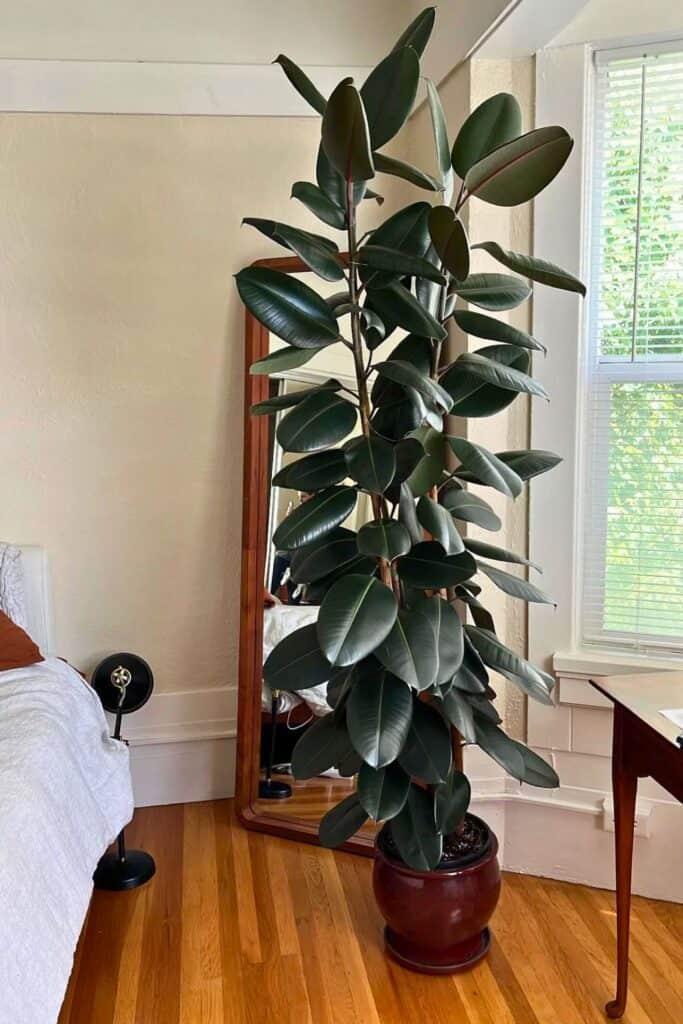
In winter, I move my plants as close to windows or glass doors as I can. Natural light is in short supply, so every bit helps.
I’ve noticed cleaner leaves when they’re near bright, indirect light. Plus, the plants just look happier.
I avoid pressing them right against cold windows—nobody likes a draft. A bit of space keeps them warm and still lets them soak up the sun.
If a room is too dark, I’ll shuffle things around to find the sunniest spot. Even a little extra daylight can make a difference.
Less dust, more light, and healthier plants—what’s not to love?
Why Winter Plant Cleaning Matters
During winter, I focus on removing dust, trimming dead leaves, and keeping an eye out for pests. Clean plants just handle low light and dry air better.
When I dust leaves, they absorb more light. Even a thin layer of dirt can slow things down, and clean leaves breathe easier.
Trimming away dried or yellow leaves keeps the plant from wasting energy. Plus, it just looks better.
Wiping down stems and checking under leaves helps me catch pests early. That’s saved me from bigger problems more than once.
Clean plants seem to bounce back faster in spring. They’re already strong and ready to put out new growth without missing a beat.
Common Winter Challenges
Winter can be a bit rough—there’s less sunlight, the air is chilly, and heating systems dry out the house. My plants seem to slow down, and honestly, it’s easy for dust and sneaky pests to settle in without me noticing.
Dry air? It’s a real culprit for those crispy brown leaf tips. I try to clean and mist the leaves, hoping it helps them hang onto a bit more moisture. It’s a small thing, but it seems to make a difference.
Low light makes plants a little weaker, but if I keep the leaves clean, they can soak up every bit of brightness that comes through. I nudge the dust-free ones closer to the windows so they don’t miss out on those short winter days.
The biggest challenge is balance. Too much water in winter can cause root rot, but if I back off too much, the plants get stressed. Cleaning gives me a chance to check how the soil feels and tweak my care before anything gets out of hand.
Safe Cleaning Practices for Delicate Plants
I’m all about keeping delicate plants clean, but I don’t want to hurt them in the process. The right tools matter, and I’m careful not to let too much water seep into the soil.
Choosing Gentle Cleaning Tools
I always reach for soft materials when I’m cleaning fragile leaves. Microfiber cloths, a soft makeup brush, or even a damp cotton ball—they’re all kinder than rough sponges or paper towels. No one wants scratched-up leaves.
When I deal with fuzzy or textured leaves, I skip the water spray and just dust them off with a dry brush. For smooth leaves, I’ll wipe with a damp cloth, but I’m careful not to press too hard.
I keep a little kit just for plant care. It usually has:
- Soft brush for gentle dusting
- Spray bottle with a fine mist
- Microfiber cloth for wiping leaves
With the right tools, I can keep leaves healthy and free from buildup—no damage, just clean plants.
Preventing Overwatering During Cleaning
I really try to watch how much water gets to the soil when I’m cleaning. Too much can lead to root rot, especially in winter since plants aren’t drinking much. To help, I’ll cover the soil with a paper towel or some plastic wrap before I mist or wipe the leaves.
If I need to rinse a plant, I’ll tilt the pot so the extra water runs off instead of soaking the soil. Then I let it drain completely before putting it back in its spot.
For plants that hate wet leaves, I just stick to dry cleaning with a brush. That way, they’re clean but the roots stay safe from extra moisture.
By being careful with water, I can keep my plants looking good and avoid any messy problems.
Frequently Asked Questions
I try to stick with simple steps to help my plants through the cold months. Things like frost protection, safe snow removal, easy cleaning, pest checks, succulent care, and figuring out when to water.
How can I protect my plants from frost during winter?
I cover outdoor plants with frost cloths or old blankets when the temperature drops. Sometimes I’ll move potted plants closer to the house or tuck them in the garage to keep them a bit warmer.
What are some safe ways to remove snow from my outdoor plants?
I gently shake snow off branches before it gets too heavy. If it’s already piled up, I’ll use a soft broom and brush it off carefully so I don’t snap any stems.
Can you suggest any homemade remedies for cleaning dusty indoor plant leaves?
I usually dust leaves with a soft microfiber cloth. Every now and then, I’ll use a diluted vinegar spray or even a bit of milk to keep them clean and give them a little shine.
What’s the best way to prevent winter plant pests in my indoor garden?
I check leaves often for tiny bugs and wipe them down as soon as I spot anything. Keeping the area tidy and not overwatering helps too—pests seem to love damp soil.
Are there any specific winter plant care tips for succulents?
I mist succulents lightly instead of watering a lot. And I always try to put them somewhere bright, since they’ll stretch if they don’t get enough light when the days are short.
How often should I water my plants in the colder months?
I tend to water less in winter since plants aren’t exactly in a hurry to grow.
Honestly, I just poke my finger into the soil—if it feels dry a couple inches down, that’s when I give them a drink.
Recommended Garden Supplies
| Product Image | Our Recommended Gardening Supplies | Check Offers! |
|---|---|---|
Top Top
Top
Top
Top
Top
Top
Top
Top | rePotme Houseplant and Tropical Classic Potting Soil Mix | Check Offer On Amazon |
 Top
Top
Top
Top
Top
Top
Top
Top | Espoma Organic Indoor Plant Food | Check Offer On Amazon |
 Top
Top
Top
Top
Top
Top
Top
Top | GooingTop LED Grow Light 6000K Full Spectrum Clip Plant Growing Lamp | Check Offer On Amazon |
 Top
Top
Top
Top
Top
Top
Top
Top | Soil Moisture Meter | Check Offer On Amazon |
 Top
Top
Top
Top
Top
Top
Top
Top | Govee Hygrometer Thermometer, Bluetooth Enabled! | Check Offer On Amazon |
 Top
Top | LEVOIT Humidifiers for Large Room(Best For Plants) | Check Offer On Amazon |
 Top
Top
Top
Top
Top
Top
Top
Top | Upgraded DIY Automatic Drip Irrigation Kit, 15 Potted Houseplants Support | Check Offer On Amazon |
 Top
Top
Top
Top
Top
Top
Top
Top | Stainless Steel Heavy Duty Gardening Tool Set | Check Offer On Amazon |
 Top
Top
Top
Top
Top
Top
Top
Top | Bonide Insecticidal Soap | Check Offer On Amazon |
 Top
Top
Top
Top
Top
Top
Top
Top | Bonide 32 oz Spray Neem Oil for Organic Gardening | Check Offer On Amazon |
 Top
Top
Top
Top
Top
Top
Top
Top | Garden Safe Fungicide | Check Offer On Amazon |

